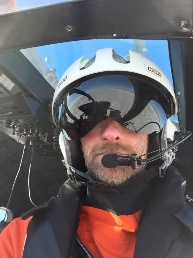Helicopter operations onboard (daylight conditions)
Helmets must be worn in the helicopter for safety reasons at all times. Immersion suites with a self-inflatable life vest are obligatory during flights. The equipment is available onboard.
A survival package is taken along for each person and a tent for 4 persons. The equipment is present onboard.
The equipment is weight-optimized and only planned for absences of max. 12h. There is no food in the equipment and the fuel bottle needs to be filled on board!
One helicopter stays onboard or in the close vincinity of the ship ( < 3 nm) for safety reasons, while the other is in use.
The used helicopter is flown by a pilot, the other pilot occupies the "Tower" onboard.
Theoretically, there are 7 places available for passengers.
However, only 5 passengers can come along plus the pilot because all 6 persons must be rescued in case of emergency. (Pilot+Doc. + 6 persons of helicopter 1 ==> 8 persons in helicopter 2) Rescue of all persons on the ice has to be possible with only one helicopter operation so that no one stays behind in case of e.g. a weather deterioration, helicopter crash, break-up of ice floes or polar bear attack.
Only one group will be allowed in the field at the same time due to the above mentioned reasons.
Stand-by of a helicopter on site is 45 minutes. If longer stays are required the helicopter goes back to the ship and collects the group later. In this case the group must be equipped with GPS and Iridium telephone. There are 2 Iridium telephones available onboard from the communication electronics engineer.
There will be a meeting of chief scientist, captain, pilot and meteorologist before every flight for discussing the flight plan. The decision if flying is possible or not has to be unanimous. The pilot always has the final word . The flight programme must be documented in writing.
The pilot can always abort the operation. This decision is mandatory and must be followed immediately.
If only one helicopter is operational for technical reasons, the other helicopter may operate within 10 NM of the ship only. Thus, in case of emergency rescue measures can be undertaken from the ship in due time.
It must always be expected that the group of 6 persons can not be collected in time because of weather conditions. The position of the working area has to be chosen thus that rescue by the ship or other means is possible in an acceptable time.
It might be that the helicopter operator needs to obtain permissions for take-off and landing before the expedition through local air administrations. Therefore you should announce your flight plans to the chief scientist at an early stage.
Examples for load and range:
Persons
(95kg each) | Load (kg) | Range
(nm) |
|---|
| 1 pilot + 2 scien. | 300 | 95 |
| 1 pilot + 2 scien. | 500 | 60 |
| 1 pilot + 2 scien. | 600 | 30 |
| 1 pilot + 4 scien. | 100 | 95 |
| 1 pilot + 4 scien. | 300 | 60 |
| 1 pilot + 4 scien. | 400 | 30 |
| 1 pilot + 6 scien. | 0 | 80 |
| 1 pilot + 6 scien. | 100 | 60 |
| 1 pilot + 6 scien. | 200 | 30 |
External load
(kg) | Range
(nm) |
|---|
| 1000 | max. 15 |
| 950 | max. 30 |
| 850 | max. 50 |
Ask the flight officer about the payloads and external loads of your specific flight operations.



